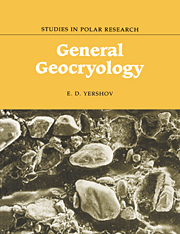Book contents
- Frontmatter
- Contents
- Editor's note
- Acknowledgements
- Notes on translations and definitions
- Abstract
- Preface
- Introduction
- I Thermal-physical, physico-chemical and mechanical processes in freezing, frozen and thawing ground and their manifestation in the permafrost regions
- II Composition, cryogenic structure and properties of frozen rocks
- III Principles of the formation and development of the frozen strata and layers of seasonal freezing and thawing
- IV Regional features and evolution of permafrost
- 14 Permafrost evolution in the Earth's history
- 15 Zonal and regional features of present-day geocryological conditions in the territories of the former USSR
- 16 Principles and methods for regional geocryological investigations
- V Rational use of frozen ground and environmental protection in the course of economic development of the permafrost regions
- References
- Index
15 - Zonal and regional features of present-day geocryological conditions in the territories of the former USSR
Published online by Cambridge University Press: 03 November 2009
- Frontmatter
- Contents
- Editor's note
- Acknowledgements
- Notes on translations and definitions
- Abstract
- Preface
- Introduction
- I Thermal-physical, physico-chemical and mechanical processes in freezing, frozen and thawing ground and their manifestation in the permafrost regions
- II Composition, cryogenic structure and properties of frozen rocks
- III Principles of the formation and development of the frozen strata and layers of seasonal freezing and thawing
- IV Regional features and evolution of permafrost
- 14 Permafrost evolution in the Earth's history
- 15 Zonal and regional features of present-day geocryological conditions in the territories of the former USSR
- 16 Principles and methods for regional geocryological investigations
- V Rational use of frozen ground and environmental protection in the course of economic development of the permafrost regions
- References
- Index
Summary
Distribution of permafrost and spatial variations of its mean annual temperature
The great extent of the territories of the former USSR from west to east and from north to south, the complexity of orographic, geological, tectonic and hydrogeological structures, of landscape and of climate, together with the changes in the late Cenozoic, are responsible for the variety of geocryological conditions in their different parts.
The zonal distribution of permafrost in the territory of the former USSR is associated with two main circumstances:
the history of the cryogenic development of the upper layers of the Earth's crust in Neogene-Quaternary time during which the stage was set for the present geocryological conditions;
the present conditions of heat exchange at the surface and in the ground. The mean annual ground temperature for the particular period, including for short-period fluctuations, indicates the level of heat-exchange for every climatic sequence.
The present heat-exchange conditions under which the mean annual ground temperatures are being formed, are defined by the following basic factors and conditions:
the dependence on latitude of the incoming solar radiation, upon which depends the radiation balance at the Earth's surface;
the effect of the Atlantic, Arctic and Pacific oceans on the atmospheric circulation, which gives the regional nature of climate;
the distance between the territory and sea basins and the position of the territory within the continent, this being responsible for the climatic continentality, i.e. for the amplitude of the annual fluctuation of temperature of the air and of the Earth's surface;
[…]
- Type
- Chapter
- Information
- General Geocryology , pp. 435 - 463Publisher: Cambridge University PressPrint publication year: 1998

